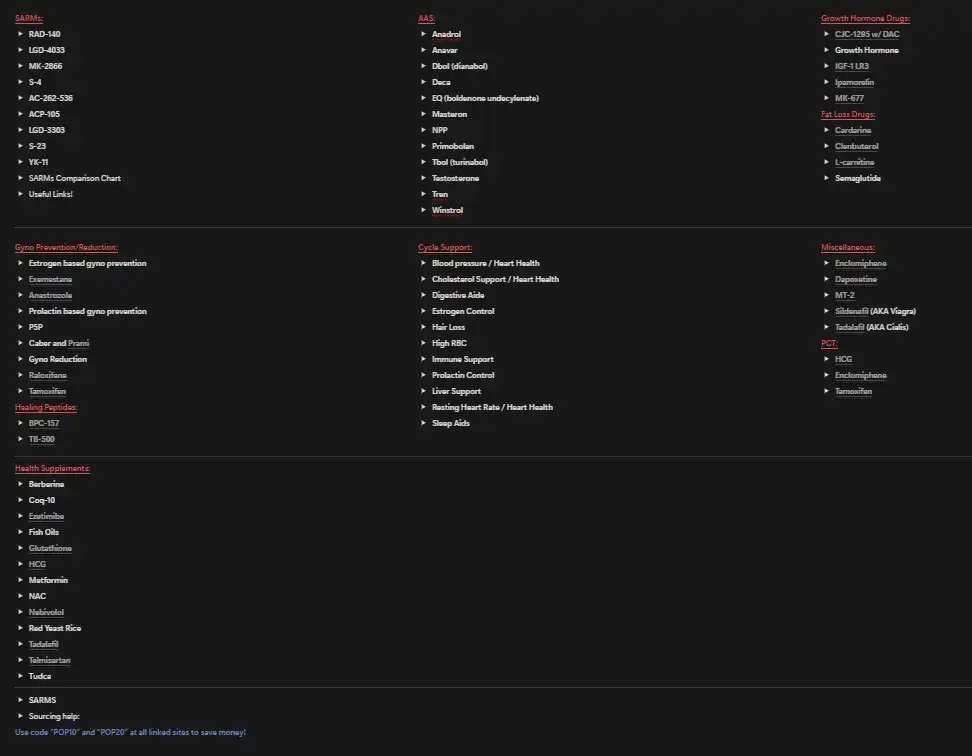Die meisten Anwender, die SARMs anstelle von AAS (anabole androgene Steroide) einnehmen, tun dies, um ihre natürliche Testosteronproduktion zu erhalten und eine lange und schmerzhafte Erholungsphase zu vermeiden. Daher sind die ersten SARMs, die sie sich ansehen, diejenigen, die als die mildesten in Bezug auf die Testosteronunterdrückung bekannt sind:
Dieser Artikel ist ein umfassender PCT-Leitfaden für diese SARMs. Er basiert auf den neuesten wissenschaftlichen Daten zu diesen SARMs, der sorgfältigen Analyse von Tausenden von anekdotischen Berichten im Internet und meinen eigenen Experimenten mit mir selbst und über 500 lebenslangen Klienten unter Bedingungen, die als so kontrolliert wie möglich gelten. Beachten Sie.
Ostarine, S-4, ACP-105 und AC-262-536 verursachen selten einen Grad an Testosteronunterdrückung, der eine PCT (Post-Cycle-Therapie) mit einem SERM (selektiver Östrogenrezeptor-Modulator) erforderlich macht. Diese sind als einige der am wenigsten unterdrückenden SARMs bekannt, und die meisten Anwender erleben einen Grad an Unterdrückung, der auf natürliche Weise wiederherstellbar ist
Nach einem Zyklus von einem der beiden können Sie davon ausgehen, dass Ihr endogener Testosteronspiegel bei etwa 50 % des Wertes vor dem Zyklus liegt.
Diese Schätzung ist der Durchschnittswert, der auf empirischen Daten von Blutuntersuchungen nach dem Zyklus basiert, die ich mir angesehen habe. Die meisten Menschen erreichen ihren natürlichen Testosteronspiegel innerhalb eines Monats wieder oder nähern sich ihrem Ausgangswert an.
Dies ist jedoch nicht bei allen der Fall. Wie ich in vielen Einzelfällen beobachtet habe, benötigen einige Anwender tatsächlich eine PCT. In der Regel hatten diese Anwender bereits niedrige Testosteronspiegel, und wir sind nicht an der idealen Stelle für einen Zyklus. Ich sage in der Regel, weil es nicht immer der Fall ist. Die individuelle Reaktion spielt eine Schlüsselrolle. Deshalb sollten Sie immer ein SERM zur Hand haben, egal wie sicher Sie sich der natürlichen Fähigkeit Ihres Körpers zur Erholung sind – nur für den Fall.
Bei leicht unterdrückenden SARMs ist es etwas knifflig, festzustellen, ob eine PCT notwendig ist. Letztendlich kommt es immer auf die Blutuntersuchung an.
Eine Blutuntersuchung nach dem Zyklus ist die genaueste Methode, um festzustellen, ob Sie nach einem Zyklus mit:
Wenn Sie aus irgendeinem Grund keine Blutuntersuchung durchführen können oder wollen, können Sie wahrscheinlich auf eine PCT verzichten, es sei denn, Sie spüren die Symptome der Unterdrückung gegen Ende und nach Ihrem Zyklus. Dazu gehören:
Wenn Sie sich Ihre Blutwerte ansehen, sollten Sie eine PCT durchführen, wenn:
Sobald Sie festgestellt haben, dass Sie eine PCT benötigen, befolgen Sie dieses Protokoll:
Jedes der SERMs kann als PCT für leicht unterdrückende SARMs eingesetzt werden. Ich empfehle jedoch, sich für Tamoxifen, Toremifen oder Enclomifen zu entscheiden, um optimale Ergebnisse zu erzielen.
Wie gesagt, jedes der SERMs ist wirksam, um Ihren Testosteronspiegel auf den Ausgangswert zu bringen, selbst bei einer niedrigen Dosis für 3 Wochen nach Ihrem Zyklus.
Diese SARMs sind mild und Sie werden höchstwahrscheinlich keine PCT benötigen. Obwohl man nie sicher sein kann, ist es immer klug, Blutuntersuchungen durchzuführen und ein SERM zur Hand zu haben, nur für den Fall. Und natürlich ist die Wahrscheinlichkeit, dass Sie nach Ihrem Zyklus eine PCT benötigen, umso höher, je höher die Dosis ist und je länger Sie eines dieser SARMs einnehmen.
Viel Spaß beim Zyklus.
erstklassige Ressourcen

Alles, was Sie jemals über SARMs wissen wollen oder müssen, um sie zu verwenden und sich von ihnen zu erholen. Enthält auch andere Forschungschemikalien.

Erfahren Sie, wie jedes der Peptide wirkt, wie Sie sie verwenden können und wie Sie das perfekte Peptid (oder Stack) finden, um Ihre Ziele zu erreichen. Enthält über 16 Peptide.

Wünschen Sie sich einen EINZIGEN umfassenden, leicht verständlichen Leitfaden, der Sie umfassend über die sichere und wirksame Anwendung von Anabolika informiert?

Verbessern Sie die Funktion des Penis, erhalten Sie härtere, vollere und länger anhaltende Erektionen, steigern Sie Ihre Ausdauer im Bett und halten Sie länger durch, schaffen Sie mehr Runden.

Eine Zusammenfassung von allem, was Sie über die möglichst sichere Anwendung von PROHORMONES wissen müssen.

A document I originally made for my clients. A neat map to the sphere of PEDs and supplements.
You'll receive the link and a once-a-week PED-related article in your inbox upon subscribing.
A special gift to all my email subscribers. The PED Dictionary is a DOC designed to help you navigate the world of enhanced bodybuilding. A game changer for beginners that want to learn more but don't know where to start, and a must-have handbook for even the most advanced enhanced researchers.